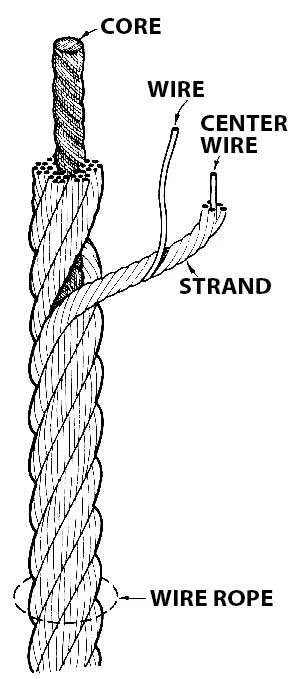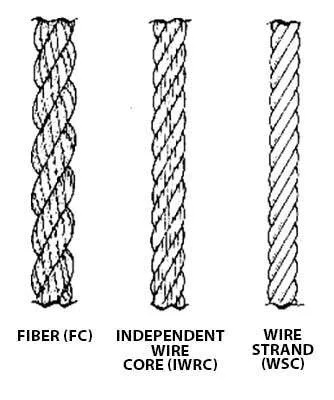Exploring the Components that Compose Wire Ropes
Exploring the Components that Compose Wire Ropes
While they may be few in number, these components exhibit variations in both complexity and arrangement, tailored to create ropes with distinct purposes or characteristics. The fundamental building blocks of a standard wire rope design consist of three crucial elements: 1) individual wires that make up the strand, 2) multiple wire strands arranged helically around a central core, and 3) the core itself (refer to Figure 1).


Wire ropes are manufactured using a variety of materials and types of wire, including steel, iron, stainless steel, monel, and bronze. Among these, high-carbon steel stands out as the most commonly used material. It comes in numerous grades, each possessing properties aligned with the fundamental requirements for steel rope wire. Wire rope manufacturers carefully choose the appropriate wire type that suits the specific needs of the final product.
Wire rope grades fall into categories such as traction steel (TS), mild plow steel (MPS), plow steel (PS), improved plow steel (IPS), extra improved plow steel (EIPS), and extra extra improved plow steel (EEIPS). (These designations originated during the early stages of wire rope development and continue to serve as references to the strength of specific sizes and grades of rope.) The strength of any steel wire grade, measured in psi, is not constant; it varies with diameter and is highest in the smallest wires.
The most common finish for steel wire is typically "bright" or uncoated. Steel wires can also undergo galvanization, a process where they are coated with zinc. "Drawn galvanized" wire matches the strength of bright wire, whereas wire "galvanized at finished size" is generally 10% weaker in strength. In certain applications, "tinned" wire finds use, although it's important to note that tin doesn't offer the same sacrificial (cathodic) protection for steel as zinc does. Different coatings are available to meet various application requirements.
"Iron" type wire is essentially drawn from low-carbon steel and is mainly limited to older elevator installations. If used outside of elevator contexts, it is often subjected to galvanization.
Stainless steel ropes, ordered by frequency of use, are crafted from AISI types 302/304, 316, and 305. Contrary to common perception, hard-drawn stainless Type 302/304 is magnetic. Type 316 exhibits less magnetism, while Type 305 boasts a permeability low enough to qualify as non-magnetic.
Monel metal wire is typically Type 400 and adheres to Federal Specification QQ-N-281. Bronze wire, on the other hand, is usually Type A Phosphor Bronze, although other bronze variants may be specified on occasion.
Strands are formed by grouping two or more wires, arranged in various geometric configurations or a combination of steel wires with materials like natural or synthetic fibers. The potential number of wires in a strand or strands in a rope is vast. The following section, "IDENTIFICATION and CONSTRUCTION," provides a detailed account of wire rope arrangements.
The core serves as the essential support for a wire rope, ensuring proper support for strands during regular bending and loading. Core materials include fibers (hard vegetable or synthetic) and steel. A steel core could consist of either a strand or an independent wire rope. The three most common core designations are: fiber core (FC), independent wire rope core (IWRC), and wire strand core (WSC) (refer to Figure 2). Catalog descriptions of available ropes consistently incorporate these abbreviations to indicate the core type.
In summary, a wire rope is typically composed of three primary constituents: wires, strands, and a core (see Figure 1). Additionally, a fourth element could be considered: the wire rope's lubricant, a critical factor in ensuring the optimal performance of most operational ropes.
Figure 2 showcases the trio of fundamental wire rope cores. When determining the ideal core for a specific application, it is advisable to seek guidance from a wire rope manufacturer.
The core serves as the fundamental foundation of a wire rope. If the core lacks the capacity to bear the compressive load applied, the rope will lose the space between strands, leading to a reduced service life. In cases where doubts arise regarding the sufficiency of a fiber core's support, it is prudent to opt for steel cores (WSC or IWRC). Additionally, in environments where temperatures could exceed 180º (82ºC), the adoption of steel cores becomes essential.
While they may be few in number, these components exhibit variations in both complexity and arrangement, tailored to create ropes with distinct purposes or characteristics. The fundamental building blocks of a standard wire rope design consist of three crucial elements: 1) individual wires that make up the strand, 2) multiple wire strands arranged helically around a central core, and 3) the core itself (refer to Figure 1).
Wire ropes are manufactured using a variety of materials and types of wire, including steel, iron, stainless steel, monel, and bronze. Among these, high-carbon steel stands out as the most commonly used material. It comes in numerous grades, each possessing properties aligned with the fundamental requirements for steel rope wire. Wire rope manufacturers carefully choose the appropriate wire type that suits the specific needs of the final product.
Wire rope grades fall into categories such as traction steel (TS), mild plow steel (MPS), plow steel (PS), improved plow steel (IPS), extra improved plow steel (EIPS), and extra extra improved plow steel (EEIPS). (These designations originated during the early stages of wire rope development and continue to serve as references to the strength of specific sizes and grades of rope.) The strength of any steel wire grade, measured in psi, is not constant; it varies with diameter and is highest in the smallest wires.
The most common finish for steel wire is typically "bright" or uncoated. Steel wires can also undergo galvanization, a process where they are coated with zinc. "Drawn galvanized" wire matches the strength of bright wire, whereas wire "galvanized at finished size" is generally 10% weaker in strength. In certain applications, "tinned" wire finds use, although it's important to note that tin doesn't offer the same sacrificial (cathodic) protection for steel as zinc does. Different coatings are available to meet various application requirements.
"Iron" type wire is essentially drawn from low-carbon steel and is mainly limited to older elevator installations. If used outside of elevator contexts, it is often subjected to galvanization.
Stainless steel ropes, ordered by frequency of use, are crafted from AISI types 302/304, 316, and 305. Contrary to common perception, hard-drawn stainless Type 302/304 is magnetic. Type 316 exhibits less magnetism, while Type 305 boasts a permeability low enough to qualify as non-magnetic.
Monel metal wire is typically Type 400 and adheres to Federal Specification QQ-N-281. Bronze wire, on the other hand, is usually Type A Phosphor Bronze, although other bronze variants may be specified on occasion.
Strands are formed by grouping two or more wires, arranged in various geometric configurations or a combination of steel wires with materials like natural or synthetic fibers. The potential number of wires in a strand or strands in a rope is vast. The following section, "IDENTIFICATION and CONSTRUCTION," provides a detailed account of wire rope arrangements.
The core serves as the essential support for a wire rope, ensuring proper support for strands during regular bending and loading. Core materials include fibers (hard vegetable or synthetic) and steel. A steel core could consist of either a strand or an independent wire rope. The three most common core designations are: fiber core (FC), independent wire rope core (IWRC), and wire strand core (WSC) (refer to Figure 2). Catalog descriptions of available ropes consistently incorporate these abbreviations to indicate the core type.
In summary, a wire rope is typically composed of three primary constituents: wires, strands, and a core (see Figure 1). Additionally, a fourth element could be considered: the wire rope's lubricant, a critical factor in ensuring the optimal performance of most operational ropes.
Figure 2 showcases the trio of fundamental wire rope cores. When determining the ideal core for a specific application, it is advisable to seek guidance from a wire rope manufacturer.
The core serves as the fundamental foundation of a wire rope. If the core lacks the capacity to bear the compressive load applied, the rope will lose the space between strands, leading to a reduced service life. In cases where doubts arise regarding the sufficiency of a fiber core's support, it is prudent to opt for steel cores (WSC or IWRC). Additionally, in environments where temperatures could exceed 180º (82ºC), the adoption of steel cores becomes essential.
Contact: Bonny Zhu
Phone: +8613854893387
E-mail: info@stainless-wire-rope.net
Add: Wanda plaza, Taian City, Shandong Province,China